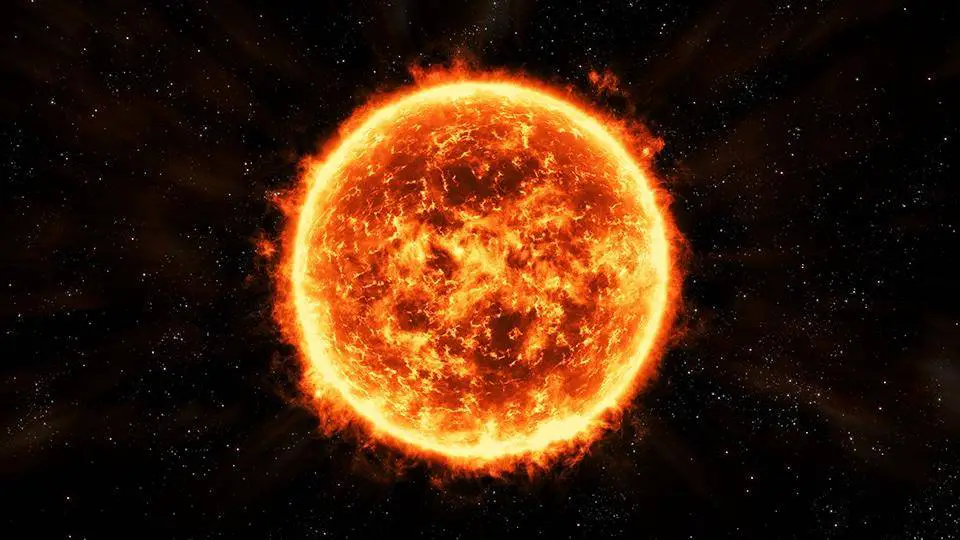Table of Contents
Sun is the King star of our Solar System made up of hot plasma. But have you ever wondered “How hot is the sun?” The answer to this question depends on which part you’re looking for.

How Hot Is The Sun?
The average surface temperature of the Sun is about 9940 Fahrenheit. Reactions taking place on the surface of the Sun produces heat energy in vast amounts. But the temperature varies as it is composed of 3 layers.
- Photosphere
- Chromosphere
- Corona

We’ll discuss all three layers in this article.
Nuclear Fusion
The Sun is a huge ball of gases that produces Light and Heat energy. This makes life on earth possible. The heat of the sun is generated by gravitational forces. These forces produce intense temperature and pressure at the core of the sun.
The Hydrogen atoms undergo the nuclear fusion reactions and fuse so potentially that they produce Helium gas. These fusion reactions produce an extensive amount of energy. According to an estimate, astronomers predicted that 4 billion years left until the sun fully burns out and turns into a white ball.
The temperature at the core of the sun is thought to reach 15 million degrees Celsius/27 million degrees Fahrenheit. The energy produced at the core moves to the outward region of the Sun.
First, the energy moves to the radiative zone where it keeps bouncing for up to 1 million years. Then it moves to the convective zone, which is the uppermost layer of the Sun’s interior.
The temperature at this layer drops below 2 million degrees Celsius/3.5 million degrees Fahrenheit.
Photosphere
The deepest layer of the Sun that can be observed directly is called the photosphere. Radiations of the Sun in this region are detected to be visible light.
At this surface of the Sun, the temperature is an immense 10,000F. It is five times hotter than the hottest volcano on the Earth. But it is not the hottest part of the Sun.
The temperature of the Sun continues to rise whether you go outward or inward on the surfaces.
Sunspots
The core of the Sun is considered the hottest part of the sun. If the core is the hottest part then which part is the coolest? Well! An interesting feature of the Sun is its Sunspots.
The areas where the magnetic field is much stronger and higher than any other part of the Sun are called Sunspots. The magnetic field in sunspots is 2500 times stronger than that on Earth. These cooler and darker areas of the Sun have a temperature of about 6380 Fahrenheit.
The magnetic pressure increases while the atmospheric pressure of the surrounding surface decreases. This, in turn, decreases the temperature at sunspots than any other place on the Sun.
Chromosphere
The next layer of the Sun’s atmosphere is Chromosphere, which is far cooler. The temperature at this part is about 7800 Fahrenheit. In this layer, the temperature gets hotter as you go far away from the Sun.
Chromosphere can not be seen directly as the visible light is weaker than that of the photosphere. It can be seen as a red ring around the Sun during a solar eclipse when the Moon covers the photosphere.
It appears red due to the presence of a large amount of Hydrogen. Viewing it for a long time without protection can cause permanent eye damage.
Corona
The outermost layer of the Sun is Corona. We assumed the temperature to drop to its coolest in this region. But in fact, this isn’t the case at all. Corona is hundreds of times hotter than the inward layers of the Sun.
In this layer, everything changes abruptly. Chromosphere can only be seen during the total solar eclipse or with the help of coronagraph. The temperature in the chromosphere changes from 1 million Celsius to about 10 million Celsius.
Chromosphere has no upper limit. The radiations that are emitted from it are blown off as the solar wind. Only a small part of these radiations reach the surface of the Earth.
The release of plasma with a magnetic field from the corona is called Coronal Mass Ejection(CME). This plasma is burst into the solar wind which is released in space. When this expulsion is directed toward the Earth it may cause a geomagnetic storm.
CME can disrupt radio wave transmissions, damage satellites, and may cause long-lasting power outages.
Scientists are not yet sure about the phenomenon occurring on the solar Corona. Some believe that it is due to the magnetic field or strong energy waves released from the surface of the Sun. Scientists recently discovered the mechanism of nanoflares.
Nanoflares are the tiny explosions taking place on the Sun’s surface that rapidly dissipate. Although the scientists proposed the mechanism of nanoflares but recent technology s unable to detect them.
You may find this interesting
Google Nest- The wonder device for your home
Filo Tata – Smart Safety Insights 2020

